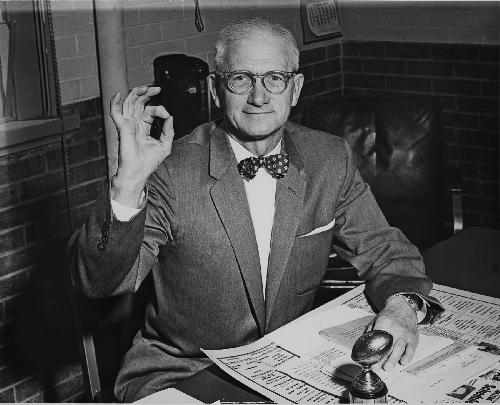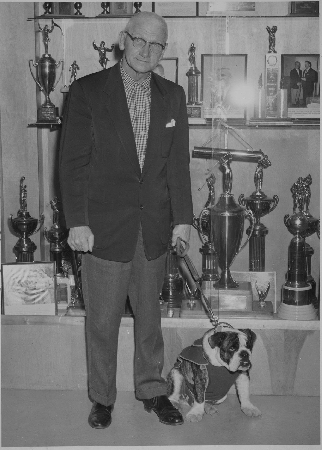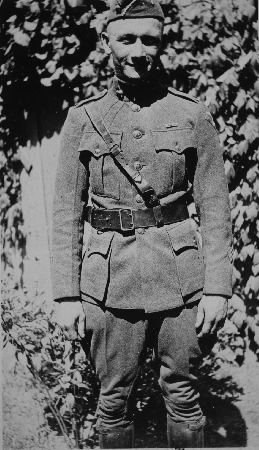University News
The Man, The Myth, The Legend
April 20, 2017
* From the Spring 2017 issue of Western: The Magazine for Alumni of Western Illinois University
By Darcie Dyer-Shinberger '89, '98
MACOMB, IL -- For 90 years, Western Illinois University has been known as the Leathernecks or the Fighting Leathernecks, but how did the University go from the "Fighting Teachers" to the Leathernecks? There's just one answer … because of one man.
Legendary World War I and World War II hero and decorated Marine Corps Colonel Ray "Rock" Hanson began his long tenure at Western in 1926. It was because of Hanson's determination and persistence, along with his Marine Corps legacy, that helped secure The Fighting Leathernecks as WIU's team name in 1927. Today, Western remains the only public school in the U.S. to use the Leathernecks as its nickname.
The Man, The Myth, The Legend
Hanson, who coached football, baseball and basketball, served as director of the physical education department and is distinguished as the longest-serving athletic director at Western.
But his story begins far before his 1926 start at Western. Hanson was born on Oct. 5, 1895 in Vasa, MN, and his family later moved to Red Wing, MN, where the young Hanson became a high school sports legend as he earned letters in football, basketball and baseball. According to the book, "First Century. A Pictorial History of Western Illinois University" by WIU English Professor and Library Archivist Emeritus John Hallwas '67 MA '68, Hanson also held the role of "player-coach" for his high school, and he led the basketball team to a state championship in his senior year. After working for one year as a railway secretary following high school graduation, Hanson joined the Marine Corps during World War I. He was assigned to a unit—later called the Devil Dogs—that would forever be a legend through Marine Corps history, the 96th Company, 1st Replacement Battalion, Sixth Regiment. Hanson survived the Battle of Belleau Wood, and he was awarded the Navy Cross for extraordinary heroism in saving the life of a fellow soldier who had been seriously wounded.
Hanson had moved through the ranks of private, corporal, sergeant, gunnery sergeant, and second lieutenant, and he won numerous medals and honors: the Navy Cross, the Silver Star, the Purple Heart, the Good Conduct Medal, the Victory Medal and the Army of Occupation of Germany Medal. Other than the burns and gassing, for which he earned the Purple Heart, Hanson had not been wounded. As WIU Professor Alfred J. Lindsey's '54 MS-Ed '60 book, "Rock Hanson, The Life of a Hero," describes, he had, however, been subject to several close calls. Machine gun bullets had pierced his helmet and had gone completely through his canteen. Part of his rifle had been demolished by a rifle shell. He had shipped home a part of a shell casing that went through his backpack and lodged in the handle of his razor, thus saving him from serious injury.
After the war's end, Hanson set back for home in July 1919. Two years later, he enrolled at Springfield College in Massachusetts, and continued to excel in athletics at the collegiate level, as he played football, basketball and baseball. According to the Hallwas book, it was at Springfield College where he became friends with world-renown Notre Dame Football Coach Knute Rockne. Hanson enrolled in a football fundamentals class with Rockne and studied under the fabled coach. Following Hanson's graduation, he worked as a coach at a Connecticut high school for one year before Rockne helped him secure a coaching position at Western Illinois State Teachers College. Hanson was hired by President Walter Morgan as the head of the Physical Education Department for Men, and as such, he was the football, basketball and baseball coach.
"When talking to alumni throughout the years who had the privilege of knowing, and playing for, Rock, Col. Hanson's goal was to make the Marine ethic a central focus at Western," said Vice President for Advancement and Public Services Brad Bainter '79 MS '83.
Among other things, Hanson introduced "the Notre Dame style" of football at Western, which involved fakes and handoffs from the quarterback to the other backs. In writing about the traits that a football player should have, Hanson stated, "A player should demonstrate leadership, fearlessness, self-confidence, enthusiasm and 'ginger'." He added that in any athletic contest "the battle is not always to the strong, but to the active, the vigilant and brave."
As Hallwas described in the First Century Book: Hanson also had a magnetic personality that drew people to him. His pep talks before games, delivered in the Knute Rockne style of blatant emotionalism, soon became legendary, and it was wasn't long before he was referred to as "Rock" by people on campus ... As his teams improved and word of his war record got out, a sort of personality cult formed around him and he came to symbolize the Western athletic tradition."
During his tenure at Western, war broke out again, and with the Japanese bombing of Pearl Harbor on Dec. 7, 1941, Hanson found himself back at Marine headquarters in Quantico, VA.
From Lindsey's book, the text from a letter Hanson wrote to President Morgan appears: "Sixteen years at Western has meant a great deal to me and it is not an easy task for me to pull up and leave. However, I do know my country comes first. Naturally, the best years of my life are left at Western—sixteen of them. My spirit and enthusiasm has been for you and the school and its march forward. I tried my best at all times."
Because of his distinguished performance in World War I and his unfailing energy, Rock's responsibility during WWII included building morale among the troops. This led to friendships with such famous movie stars and entertainers as Bob Hope, Red Skelton, Ginger Rogers, Rita Hayworth, Tyrone Power, baseball star Joe DiMaggio and boxing champ Jack Dempsey.
Following the end of the war, the then-51-year-old Hanson was back on campus by February 1946. President Frank Beu appointed Hanson as athletic director and physical education department chair. He retired in 1964 after a 38-year career at Western. Even after his retirement, Coach Hanson remained active at WIU and in the Macomb community. On Nov. 16, 1974, when the Western Sports Hall of Fame formally opened, Rock was named a charter member of the first induction class. He passed away Jan. 4, 1982, at the age of 86.
Love and Marriage
During his senior year of college, on Oct. 25, 1925, Hanson married Gladys Minor. In 1930, Ray adopted and changed the name of Gladys' son [by a previous marriage] to Edward French Hanson. "Eddie," upon his arrival in Macomb, enrolled in the 10th grade at the Training School. After almost 30 years of marriage, on May 1, 1953, Gladys passed away. As a long-time resident of Macomb, Gladys had been the past president of the Macomb American Legion Auxiliary and was a former member of the Salvation Army Board. She was also a member of the Eastern Star.
In December 1963, a month before his retirement and after being widowed for a decade, he married Dorothy Ruggles in the storied Little Chapel on the University of Iowa campus. Dorothy passed away on Apri 10, 1992, 10 years after Rock's death. Dorothy was a dietician in the Army during World War II, and served as chief dietician at the Veteran's Administration Hospital in Iowa City for 12 years. She was a member of the Wesley United Methodist Church.
Honoring the Legacy of a Legend
In 1950, during Hanson's time as athletic director, the new Western football field was named in his honor. On Sept. 23, 1950, the dedication of the field took place at halftime of the game with Central Michigan.
Today, Hanson's name lives on at Western not only through the football field name and the University's nickname, but also through Col. Rock III (aka Rocky), an English bulldog and Western's mascot, who is named in honor of this war hero and true example of a #TraditionofTough.
The first English Bulldog, a symbol of the U.S. Marine Corps, arrived at WIU in September 1959 to serve as the first official Leathernecks mascot. A few weeks later, the Student Government Association Executive Council selected the name Col. Rock for the new mascot from more than 200 entries in a naming contest. WIU student Richard Stevenson submitted the winning name.
In December 2015, the WIU Foundation, in cooperation with the University Bookstore and Western's licensing agent, Learfield Licensing, created and unveiled the Ray "Rock" Hanson Vintage Collection, which features vintage Western logos that were in place during Hanson's tenure from 1926 through 1964.
"The iconic symbol of Western's past is very much a part of the present, through the Leathernecks nickname to the school's mascot, and the Ray "Rock" Hanson Vintage Collection. These are just two ways that we can continue to pay tribute to a great man and to remember our legacy," said Bainter, who spearheaded the effort to further recognize and honor the famed Marine Corps colonel and World War I and World War II hero.
Another project is in the works to recognize Hanson, thanks to funding provided by WIU alumni Jackie '85 MS-Ed '94 and Dave Thompson '72, is the Col. Ray "Rock" Hanson memorial statue project. The larger-than-life statue, which will be created by WIU Assistant Professor of Art Duke Oursler, will be placed near the north entrance of Hanson Field, the home of the Fighting Leathernecks football team.
While Col. Hanson has been gone for nearly 30 years, laid to rest in Macomb's Oakwood Cemetery, his legacy continues each and every day at Western Illinois University.
As we say at WIU … "Every Day Is a Great Day to Be a Leatherneck."
Photos courtesy of WIU Archives.
Posted By: University Communications (U-Communications@wiu.edu)
Office of University Communications & Marketing




Connect with us: